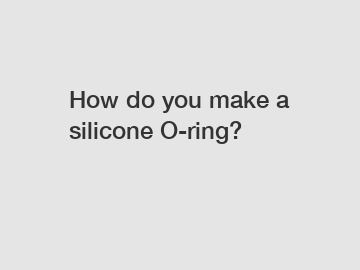How do you make a silicone O-ring?
How do you make a silicone O-ring?
When it comes to making a silicone O-ring, the process involves several steps, starting from the selection of the right material to the final product. Silicone O-rings are commonly used in various industries due to their excellent properties such as high temperature resistance, durability, and flexibility. Let's dive into the detailed process of making a silicone O-ring and explore its significance and impact.
Selection of Materials:

The first step in making a silicone O-ring is choosing the right materials. Silicone rubber, which is a synthetic polymer made from silicon, oxygen, carbon, and other elements, is the most common choice. Silicone rubber offers exceptional stability under extreme temperatures and has great resistance to chemicals and UV radiation.
Molding Process:
Once the silicone rubber is selected, the molding process begins. The rubber is typically mixed with a curing agent to initiate the vulcanization or curing process. The mixture is then poured into a mold with the desired shape and size of the O-ring. The mold is carefully designed to ensure accurate dimensions of the O-ring.
Curing and Vulcanization:
After pouring the mixture into the mold, it is subjected to heat and pressure for curing and vulcanization. The heat activates the curing agent, causing the rubber to solidify and form the O-ring shape. The pressure ensures that the rubber fills the mold completely, resulting in a uniform and defect-free O-ring.
Trimming and Inspection:
Once the O-ring is cured and cooled, it is carefully removed from the mold. Any excess material is trimmed off to achieve the desired shape and size. The O-ring then undergoes a thorough inspection to ensure its quality. It is checked for any visible defects, such as air bubbles, tears, or uneven edges, which could affect its performance.
Testing and Quality Control:
To ensure the reliability and effectiveness of the silicone O-ring, it undergoes rigorous testing. This includes evaluating its ability to withstand temperature extremes, pressure resistance, chemical resistance, and compression set. Testing methods may vary depending on the specific application and industry requirements.
Significance and Impact:
Silicone O-rings play a vital role in various industries, including automotive, aerospace, food processing, and pharmaceuticals, among others. Their ability to create a reliable seal between two mating parts makes them essential for preventing leaks and contamination. By choosing the right materials and following a precise manufacturing process, silicone O-rings ensure high performance, durability, and longevity in critical applications.
In conclusion, making a silicone O-ring involves careful material selection, precise molding, adequate curing, trimming, inspection, and thorough testing. The process ensures the production of high-quality O-rings that offer exceptional performance and reliability. The significance of silicone O-rings lies in their ability to provide effective sealing solutions in various industries, ultimately contributing to improved efficiency, safety, and productivity.
The company is the world’s best colored o rings, wholesale o-ring, china special shapes rubbers supplier supplier. We are your one-stop shop for all needs. Our staff are highly-specialized and will help you find the product you need.
30
0
0

Comments
All Comments (0)